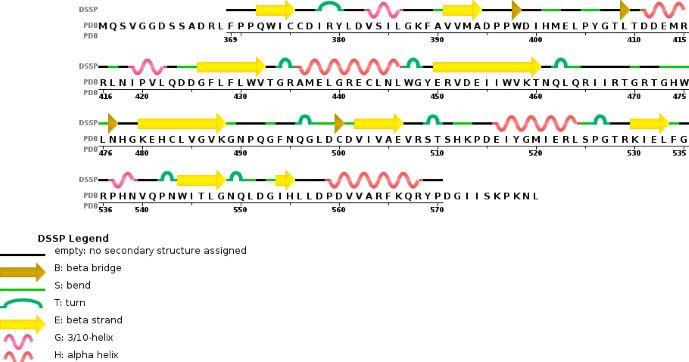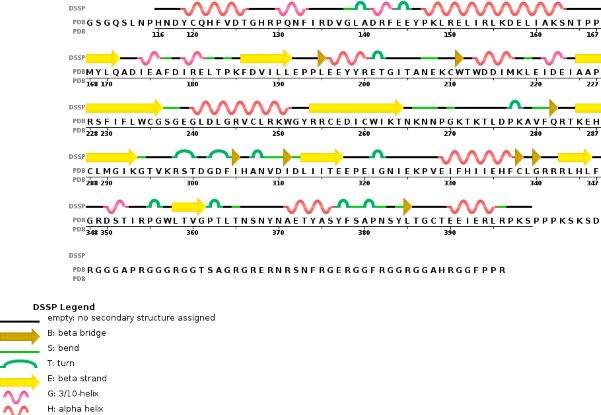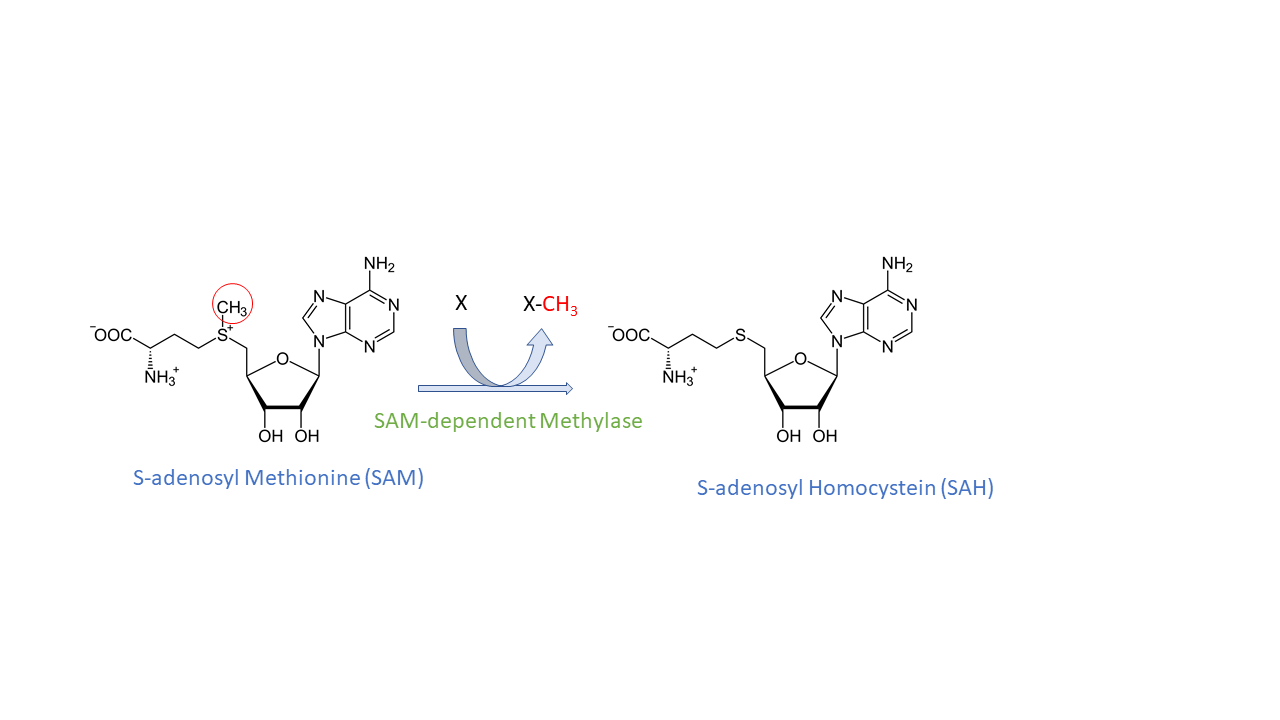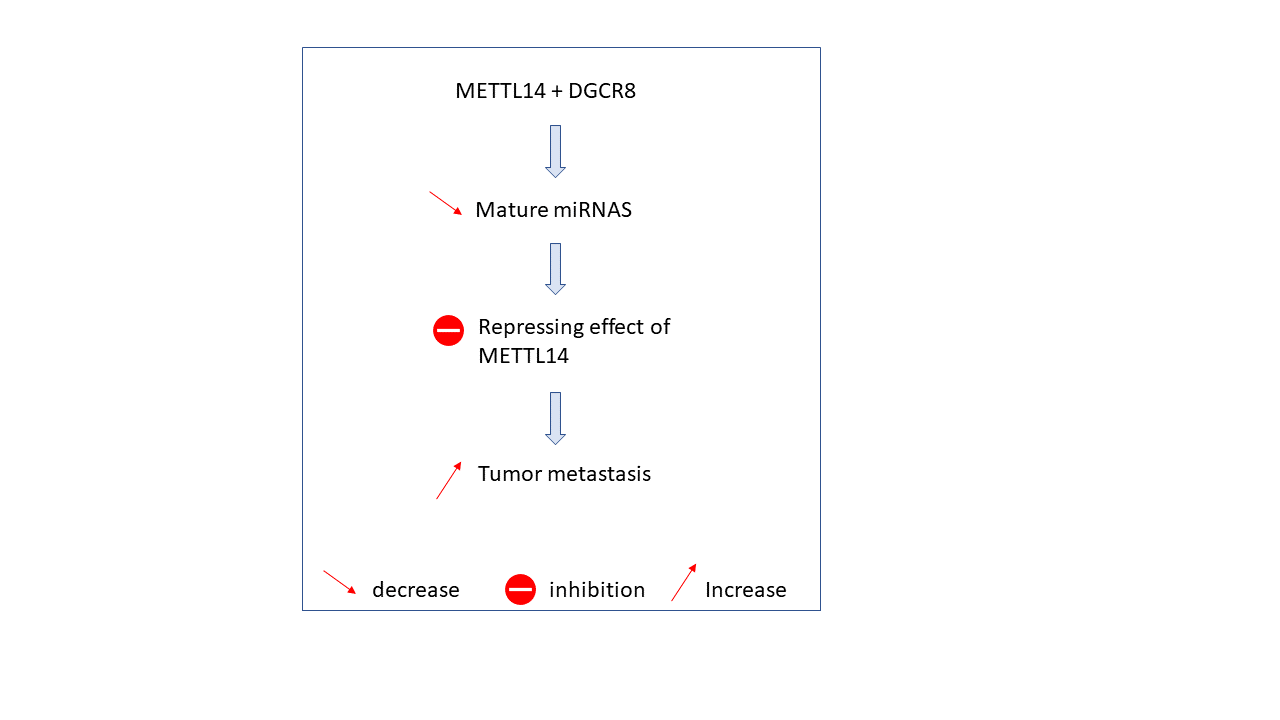Sandbox Reserved 1481
From Proteopedia
| Line 9: | Line 9: | ||
This enzymatic complex belongs to the second class of enzymes, which are the transferases and to the group of N6A-MTases. The complex is formed by 574 amino acid residues, divided into two different proteins nammed as Methyltransferase Like number 3 and 14. | This enzymatic complex belongs to the second class of enzymes, which are the transferases and to the group of N6A-MTases. The complex is formed by 574 amino acid residues, divided into two different proteins nammed as Methyltransferase Like number 3 and 14. | ||
| - | [[Image:Methylation]] | + | [[Image:Methylation.jpg]] |
== Structural highlights of the METTL3/METTL14 complex== | == Structural highlights of the METTL3/METTL14 complex== | ||
Revision as of 16:39, 5 January 2019
| This Sandbox is Reserved from 06/12/2018, through 30/06/2019 for use in the course "Structural Biology" taught by Bruno Kieffer at the University of Strasbourg, ESBS. This reservation includes Sandbox Reserved 1480 through Sandbox Reserved 1543. |
To get started:
More help: Help:Editing |
Crystal structure of the catalytic domains of Mettl3/Mettl14 complex
|
The complex METTL3/METTL14 is a heterodimer enzymatic complex involved into RNA post-transcriptional modifications by humans. This complex is abble to add a methyl group on adenosin of the RNA, by catalyzing a m6(A) modification.The N(6)-methyladenosine (m(6)A) is a quite common, reversible chemical modification of RNAs molecules, which plays a key role in several different biological fonctions. This post-transcriptional modification can be added by WRITERS, recognized by READERS and also removed byr ERASERS. The METTL3/METTL14 complex plays the role of writer.
This enzymatic complex belongs to the second class of enzymes, which are the transferases and to the group of N6A-MTases. The complex is formed by 574 amino acid residues, divided into two different proteins nammed as Methyltransferase Like number 3 and 14.
Structural highlights of the METTL3/METTL14 complex
Primary structure
This complex is composed of two differents proteins forming two distinct but linked subunits of the enzymatic complex. Each of these two proteins is coded by one different gene. The mettl3 gene codes for the N6-adenosine-methyltransferase 70 kDa subunit, which is a 225 Amino acid chain, whereas the Mettl14 gene codes for the N6-adenosine-methyltransferase subunit METTL14, which is composed of 349 amino acids. The complex is regulated by a supplementary subunit, the WTAP (Wilms' tumour 1-associating protein).
Each of these two proteins are corresponding to the A [2]or the B chain [3] of the complex and are neccessary to the functionning of the whole complex.
Secondary structure
Both polypeptides METTL3 and METTL14 are able to form some secondary structures thank to interchain and intrachain hydrogen bond formation. The core of METTL3 and METTL14 is shaped by Rossman fold domain,comprising a beta sheet edged by four alpha helices
Chain A METTL3'secondary structure, is mainly composed of 20% helical structures (7 helices; 46 residues) and 24% parallel and anti-parallel beta sheets (13 strands; 55 residues)
Chain B METTL14 is made of 24% helical structures (14 helices; 87 residues) and 18% parallel and anti-parallel beta sheets (16 strands; 63 residues)
Tertiary structure Thanks to their primary amino acid sequences both A and B chains have some specific conserved domains directly linked to their function and functionning.
Domains and specific site or sequences
METTL3 and METTL14 are linked to each other by a an extensive water-mediated hydrogen bond, which generates a positively charged groove. This groove is well-conserved throughout evolution and is composed of four amino acids of each METTL3 and METTL14. The positive charge is due to the four amino acids of METTL14 which are arginins forming a pocket occupied by an acetate ion.
MTD : Methyltransferase domain
METTL3 and MTTL14 have both a methyltranferase domain, which is the domain able to catalyze a methyltransferase reaction. But the complex METTL3/METTL14 has a better methyltransferase activity, than one single subunit activity. Moreover, a mutation in the catalytic center of METTL3 inhibits the hole methyltransferase activity of the complex, whereas a mutation in the catalytic center of METTL14 does not. Thus, METTL3 is the catalytic subunit of the complex and METTL14 enhances the methyltransferasese activity by stabilizing the complex structure and binding to messenger RNA by enabling the recognition of its consensus sequence, GGACU, which is the target for m6A modifications.
METTL3's MTD domain has an α–β–α sandwich fol. First, there are four α-helices : on one side there are α1,α2,α4 and on the other side there is α3. Then there is a mix of eight β-sheet with a a specific order and direction : β1↑, β8↑, β7↑, β2↑, β3↑,β5↓, β4↑ and β6↑. There are three other α-helices to complete the sandwich.
Both MTD have approximatly 25% sequence homology.Despite some common point, the methyltransferase domain of METTL14 has extra terminal extensions, with an unusual N-terminal extension which is approximately 50 amino acid long. In the one hand the N-terminal extension creates along helix which goes through the domain and allows a close contact with the MTD of the catalytic subunit of the complex. This contact is made by several loops and shorter helical segments. In other hand, the C-terminal helix of the MTD of METTL14 is antiparallel to the N-terminal extension helix in order to stabilize its position. This allows the formation of a broad interdomain binding interface,and also other contact point along the terminal extensions, which are stabilizing the positions of both domains neccesary for the function.
|
Zinc finger binding domain of the METTL3 subunit or the CCCH sequence
Zinc finger domain of the METTL3 N6-methyladenosine methyltransferase, is a RNA binding domain of the complex. This perticular domain of the two proteins complex allow the protein to make interactions with the RNA molecule to modify through consensus sequences
The CCCH sequences corresponds to a Cys-Cys-Cys-His motif. This specific motif belongs to METTL3 and belongs to the family of zinc binding motifs
There are two od these CCCH motifs near by the methyltransferase domain of METTL3. As zinc-binding motifs such as CCCHs are known for their abilities to bind nucleic acids such as RNA, their presence are required for RNA methylatransferase activity. In case of a punctual mutation in these sequences a loss of the methyltransferase activity is observed, confirming their importance.
METTL3 and METTL14 are linked to each other to form the functionnal complex. So as the METTL3 is responsible of the catalytic activity, the METTL14 allow the allosteric recognition of the RNA. The two subunit bindind creates a cavity in the center of the complex where the enzymatic reaction take place, it is the catalytic center. In these catalytic center some critical amino acid residues for the substrate recognition and specific binding are located.
Crystal structure
To study the crystal structure of the METTL3/METTL14 some crystalograghy experiments have been realized under the following experimental conditions to crystalyze the protein complex:
Method : Vapor Diffusion Hanging Drop
pH 8
Temperature : 291.0 K
Buffer: 0.1 M Tris pH 8.0, 20% PEG3350
After crytalization, crystal had been analyzed through X-Ray diffraction, at 100°C, with a single wavelength coming out of a synchrotron. Thanks to the experiment the following data have been collected to describe the cristal structure of the complex :
Unit Cell caracteristics : Length (Å) a = 101.86 b = 101.86 c = 117.66
Angle (°) α = 90 β = 90 γ = 90
Symmetry : Space Group P 41 21 2
The primitive cubic symmetry of the unit cell is driven by two 2-fold axis rotation. Moreover, within this space group which is acentric, chiral, and enantiomorphic with one single lattice translations, eight different representative symmetry operations are needed to get the whole unit cell.
The crystal structure analysis at 1,65 angstrom allow to collect precise and detailled informations about the whole structure like the side chains and also the hydrogen bonds. (Cristal analysis data at other resolution are available on [4].)
Complex METTL3/METTL14 enzymatic working process
The enzymatic complex of two proteins is abble to realize methylation reactions thanks to its sequence and specific which allow it to catalyze some perticular reactions at given sites.
The complex METTL3/METTL14 belongs to the writers group, which means that theses two proteins are taking part to the protein subunit able to realize the post transcriptional modification of the RNA within the humans cells.
The METTL3/METTL14 complex catalyze the methylation reaction which takes place in the nucleus.
As previously said, the METTL3 is the catalytic component of the methyltransferase complex. So it is responsible of the m6A modifications thanks to its ability to crosslink with an other essential protein the S-adenosylmethionine (SAM).SAM is the substrate donor of the reaction. It is bound in a specific site in METTL3, at the C-ter of beta 1, beta 7, and beta 8 strands. Then it is transformed into S-adenosylHomocystein (SAH). Moreover, METTL3 can be associated with METTL14, which contains its own methyltransferase domain. Even if the precise molecular interactions between the to subunits are unknown, it is known that the both have to associated with each other, but also that aditionnal factors are neccessary to allow the add of a methyl group on the targeted RNA.
After the formation of the minimal complex with the crystallized heterodimer of methyltransferase domains from METTL3 and METTL14 and two CCCH motifs of Mettl3, and the binding of all the factors the RNA modification reaction can take place. The acetate ion encasted in the arginin's pocket of the positively charged groove mediates RNA binding by mimicking RNA phosphate group.
Function of the modification within the cell
Specific, and well controlled methylation of the nucleic acids is essential for proper gene regulation, whatever the studied organism or modification’s type. However the precise molecular role of m6A is unknown, it is known that for most mRNAs, m6A modification appear in long exons, near stop codons, and in 3′ UTRs and that this modification could influence mRNA stability, induce RNA conformational changes, modulate protein-RNA interactions, and even modify microRNA processing One of the most prevalent modifications observed for mRNAs is N6-methyladenosine (m6A). Recent studies have intensely investigated how m6A-modification of RNA contributes to central events in biology. Nonfonctional m6A actors such as writers like METTL3 or METTL14, but also readers, and erasers are oftern linked to problems in self-renewal of stem cells, circadian clock and developmental defects, obesity, synaptic signaling, and cancers.
Disease and problems triggered by unfunctionnal METTL3/METTL14 complex
m6A is a process involved in stem cell differenciation, mamalian circadian clock and embryonic development. Thus, an unfunctional METTL3/METTL14 complex that impacts m6A impacts these mechanisms.
Inhibition of METTL3
m6A stimulates the RNA export out of the nucleus and eases mRNA translation by recruiting EIF3,involved in the initation machinery of translation. therefore, its inhibition could alter the translation process and lead to unfunctional proteins.
Inhibition of METTL14
WTAP splicing factor
Stem cell differenciation
A knockdown of METTL3/METTL14 in embryonic stem cells induces a loss of m6A and an inability of self-renewal. The loss of m6A stops the embryonic stem cell to leave the pluripotent state for differenciation.
Cancer progression
METTL3 plays a role in alternative pre-mRNA splicing. Indeed, a lack of METTL3 leads to a changement of the gene expression and alternative splicing related to the P53 signaling pathway wich is a tumor protein. m6A influences the processing of micro-RNAs and long non-coding RNAs splicing, which both are translational controller, and that can garble cancer progression. MeTTL3 is directly linked to lung cancer by promotting an increasing translation of mRNAs thanks to an interaction with translaion iniatiation factors (CBP80 and EIF4E). METTL14 has a repressing effect in tumor metastasis, but by interacting with DGCR8 (a protein required for micro-RNAs processing) instead of METTL3, it decreases mature micro-RNAs which at first instance inhibits the repressing effect of METTL14 in tumor metastasis, so it promotes growth of cancer cells and espacially Hepatocellular carcinoma.
Breast Cancer
It observed that in case of breast cancer, there is less and less METTL14 present in cells and is related to a shorter survival patients.
Glioblastoma
Glioblastoma stem cells' self-renewal is regulated by METTL3 thanks to its methyltransferase catalytic activity.Therefore, inhibiting all the METTL3/METTL14 complex or inhibiting only METTL3 or METTL14 leads to a reduced catalytic activity of METTL3 which is not able to regulate glioblastoma stem cells' self-renewal annd leads to the development of the brain tumor.
Endometrial cancer
Endometrail cancer patients often show to have a mutation: substitution mutation of an arginin to a proline. It is about an evolutionary conserved arginin (Arg 298) of METTL14 in the MTD3/MTD14 junction. This mutation leads to a deacrising methyl activity of the METTL3/METTL14 complex with the inability for it to recognize the RNA target.
Intestin cancer
There is a well-conserved trhoughout evolution tyrosin residue(Y406) located in the the active site of METTL3 that is required for METTL3 to interact with the RNA that needs to be methylated. Indeed, a mutation of this tyrosin is often found in intestin cancer patients.
Relevance
This is a sample scene created with SAT to by Group, and another to make of the protein. You can make your own scenes on SAT starting from scratch or loading and editing one of these sample scenes.
</StructureSection>
References
[1] [2] [3] [4] [5] [6]/ [7] [8]
- ↑ Wang P, Doxtader KA, Nam Y. Structural Basis for Cooperative Function of Mettl3 and Mettl14 Methyltransferases. Mol Cell. 2016 Jul 21;63(2):306-17. doi: 10.1016/j.molcel.2016.05.041. Epub 2016 , Jun 30. PMID:27373337 doi:http://dx.doi.org/10.1016/j.molcel.2016.05.041
- ↑ Wang X, Feng J, Xue Y, Guan Z, Zhang D, Liu Z, Gong Z, Wang Q, Huang J, Tang C, Zou T, Yin P. Structural basis of N(6)-adenosine methylation by the METTL3-METTL14 complex. Nature. 2016 May 25;534(7608):575-8. doi: 10.1038/nature18298. PMID:27281194 doi:http://dx.doi.org/10.1038/nature18298
- ↑ Wang X, Feng J, Xue Y, Guan Z, Zhang D, Liu Z, Gong Z, Wang Q, Huang J, Tang C, Zou T, Yin P. Corrigendum: Structural basis of N(6)-adenosine methylation by the METTL3-METTL14 complex. Nature. 2017 Feb 9;542(7640):260. doi: 10.1038/nature21073. Epub 2017 Jan 18. PMID:28099411 doi:http://dx.doi.org/10.1038/nature21073
- ↑ Sledz P, Jinek M. Structural insights into the molecular mechanism of the m(6)A writer complex. Elife. 2016 Sep 14;5. pii: e18434. doi: 10.7554/eLife.18434. PMID:27627798 doi:http://dx.doi.org/10.7554/eLife.18434
- ↑ Wang X, Huang J, Zou T, Yin P. Human m(6)A writers: Two subunits, 2 roles. RNA Biol. 2017 Mar 4;14(3):300-304. doi: 10.1080/15476286.2017.1282025. Epub 2017, Jan 25. PMID:28121234 doi:http://dx.doi.org/10.1080/15476286.2017.1282025
- ↑ doi: https://dx.doi.org/10.2210/pdb5K7M/pdb
- ↑ Yue Y, Liu J, He C. RNA N6-methyladenosine methylation in post-transcriptional gene expression regulation. Genes Dev. 2015 Jul 1;29(13):1343-55. doi: 10.1101/gad.262766.115. PMID:26159994 doi:http://dx.doi.org/10.1101/gad.262766.115
- ↑ Liu J, Yue Y, Han D, Wang X, Fu Y, Zhang L, Jia G, Yu M, Lu Z, Deng X, Dai Q, Chen W, He C. A METTL3-METTL14 complex mediates mammalian nuclear RNA N6-adenosine methylation. Nat Chem Biol. 2014 Feb;10(2):93-5. doi: 10.1038/nchembio.1432. Epub 2013 Dec 6. PMID:24316715 doi:http://dx.doi.org/10.1038/nchembio.1432
- ↑ . PMID:216315890657
POUR URSULA :)
m6A RNA Methylation Controls Neural Development and Is Involved in Human Diseases Kunzhao Du, Longbin Zhang[…]Tao Sun Molecular Neurobiology (2018)
The N6-methyladenosine (m6A)-forming enzyme METTL3 controls myeloid differentiation of normal hematopoietic and leukemia cells Ly P Vu, Brian F Pickering[…]Michael G Kharas Nature Medicine (2017)






